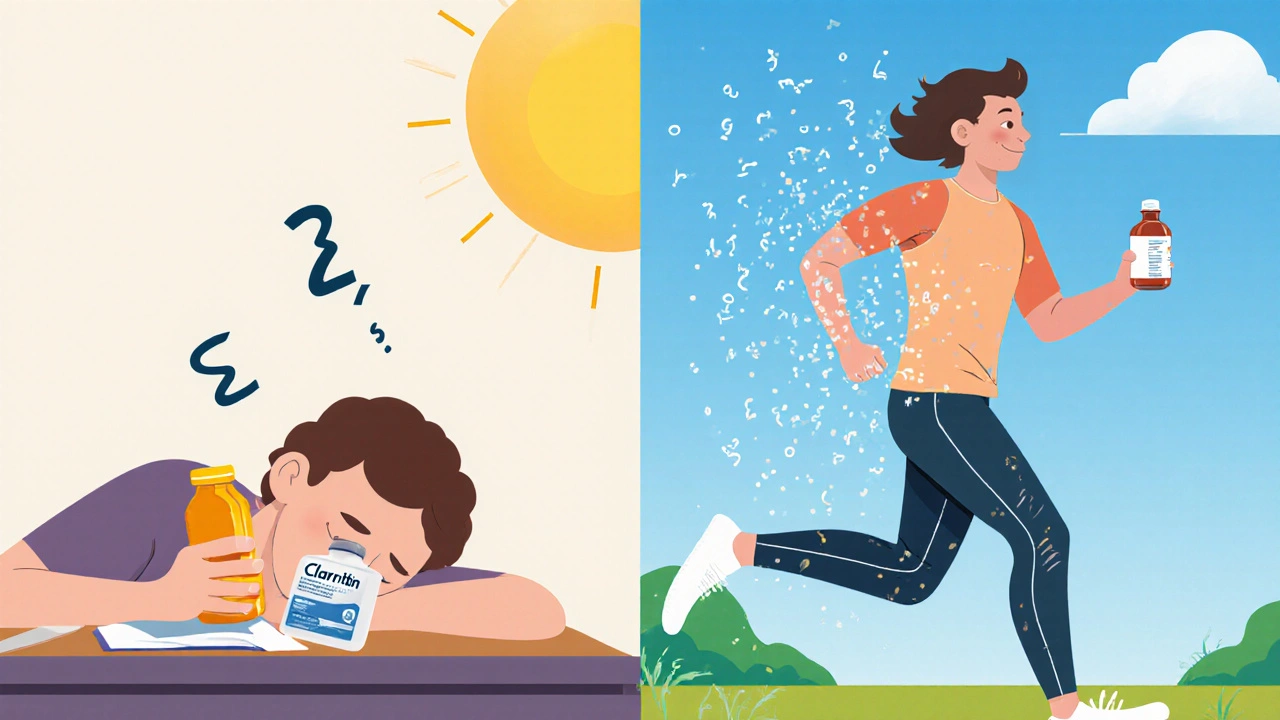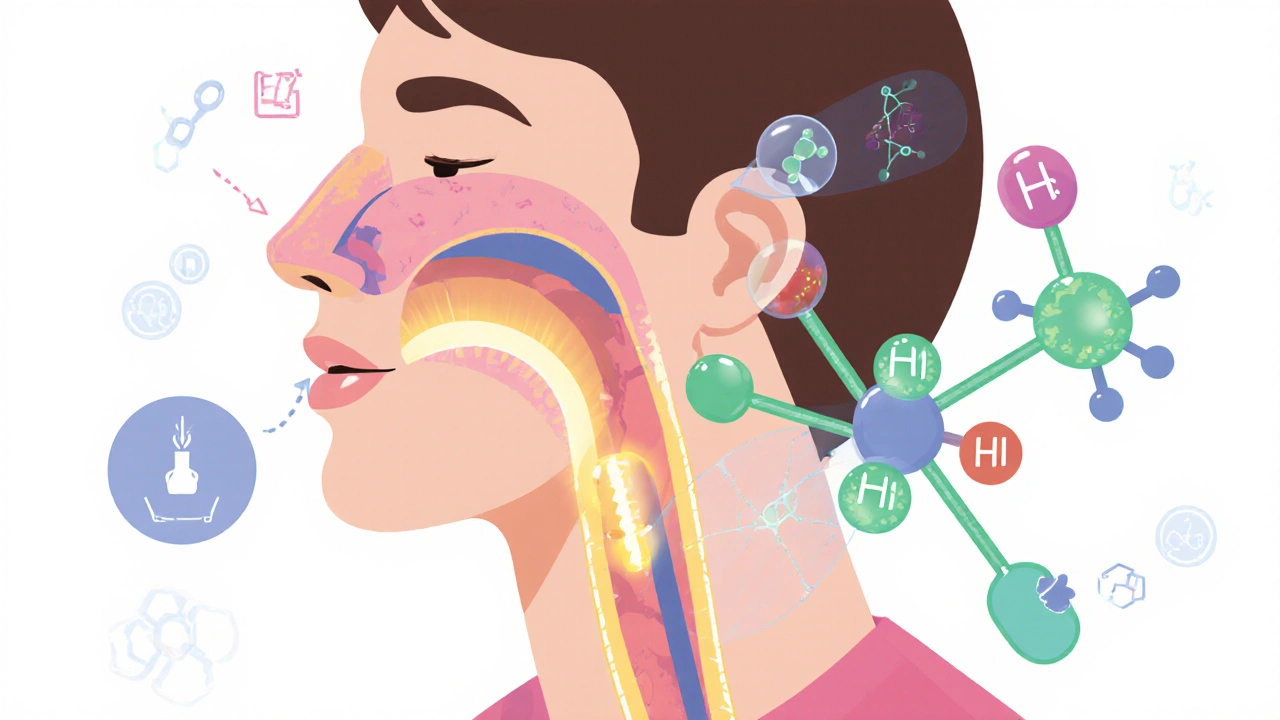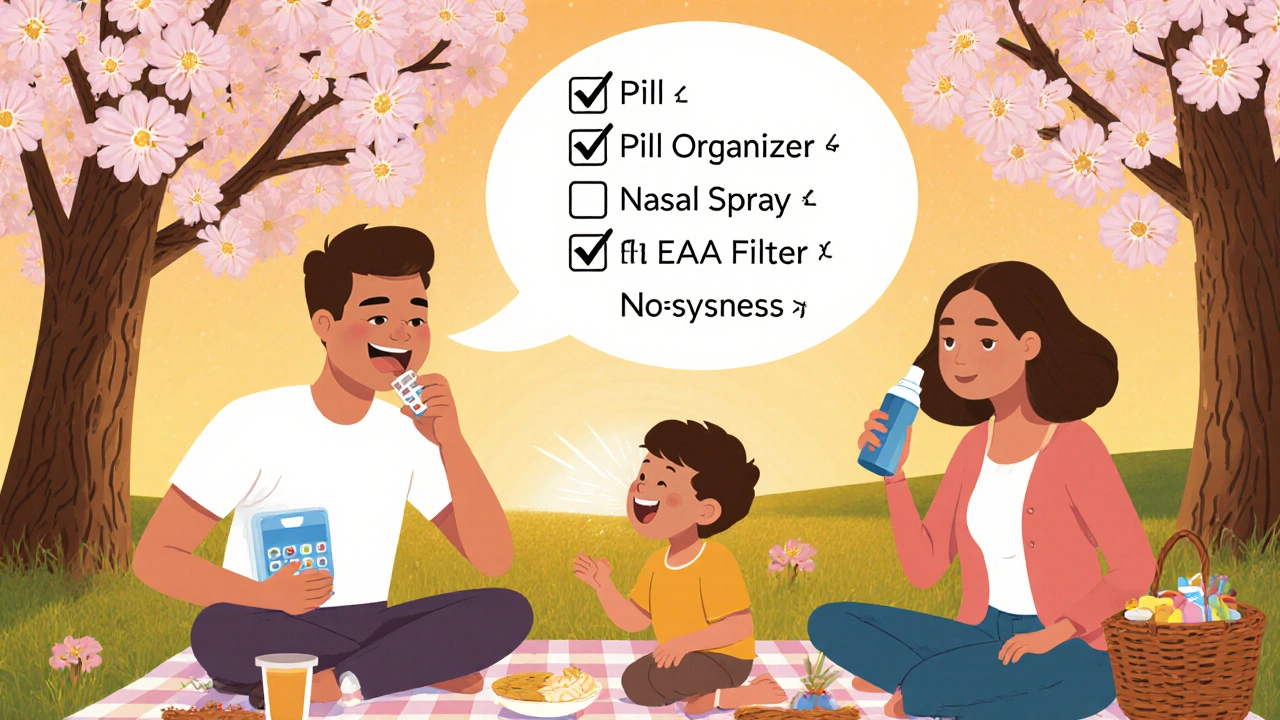Second-Generation Antihistamines: Safer, Non-Drowsy Options for Allergies
 Nov, 13 2025
Nov, 13 2025
Allergy Medication Selector
Which Antihistamine Is Right For You?
This tool helps you choose the most appropriate second-generation antihistamine based on your specific allergy symptoms, health conditions, and medications.
Your Personalized Recommendation
Select your symptoms and health conditions to see your recommended antihistamine.
Important Notes
This tool is for informational purposes only and does not replace professional medical advice. Always consult your doctor or pharmacist before starting any new medication.
Why Second-Generation Antihistamines Are the New Standard for Allergies
If you’ve ever felt sluggish after taking Benadryl for a stuffy nose or itchy eyes, you know why first-generation antihistamines fell out of favor. These older drugs worked well - but they made you sleepy, foggy, and sometimes too drowsy to drive or work. Today, millions of people with seasonal allergies, hives, or chronic itching have switched to second-generation antihistamines - and for good reason. They control symptoms just as effectively, without the heavy sedation. In fact, over 78% of U.S. adults with allergies now use them regularly, according to CDC data from 2023.
How They Work Differently From the Old Stuff
First-generation antihistamines like diphenhydramine and chlorpheniramine cross the blood-brain barrier easily. That’s why they calm your sneezes - and your brain. Second-generation versions, like loratadine (Claritin), cetirizine (Zyrtec), and fexofenadine (Allegra), are built differently. They’re larger, more polar molecules that mostly stay out of your brain. This means they block histamine in your nose, skin, and throat - where allergies happen - without slowing down your mind.
Research from Nature Communications in 2024 used cryo-electron microscopy to show exactly how these drugs bind to the H1 receptor. They latch onto a deep pocket in the receptor, preventing histamine from triggering itching, swelling, and runny nose. Because they don’t disturb brain receptors, sedation drops from 50-60% with older drugs to just 6-14% with these newer ones.
The Top Three: Cetirizine, Loratadine, Fexofenadine
Not all second-generation antihistamines are the same. Here’s how the most common ones stack up:
| Medication | Brand Name | Dose | Half-Life | Metabolism | Common Side Effects |
|---|---|---|---|---|---|
| Cetirizine | Zyrtec | 10 mg daily | 8.3 hours | Primarily liver (CYP3A4) | Drowsiness (in 23% of users), dry mouth |
| Loratadine | Claritin | 10 mg daily | 8-18 hours | Liver (CYP3A4, CYP2D6) | Headaches, fatigue |
| Fexofenadine | Allegra | 60 mg twice daily or 180 mg once daily | 11-15 hours | Minimal liver metabolism; mostly excreted unchanged | Nausea, dizziness, rare taste changes |
Cetirizine is the most likely to cause mild drowsiness - but even then, it’s far less than Benadryl. Loratadine is often called the "non-sedating" one, but some users report headaches. Fexofenadine has the cleanest profile: least liver metabolism, lowest risk of drug interactions, and the least sedation. That’s why many allergists recommend it as a first choice, especially if you’re on other medications.
What They Don’t Do - And Why You Might Still Need More
Here’s the catch: second-generation antihistamines are great for itching, sneezing, and runny nose - but they’re weak on nasal congestion. That’s because they don’t block acetylcholine, unlike first-gen drugs. If your nose is blocked, you’ll likely need a decongestant like pseudoephedrine or a nasal spray like Flonase.
Reddit users in r/Allergies say it plainly: "Fexofenadine works great for my seasonal allergies without making me sleepy like Benadryl did, but I still need Flonase for congestion." That’s not a failure of the drug - it’s just how they work. Clinical trials back this up. A 2001 study from Johns Hopkins found second-gen antihistamines had zero effect on sneezing caused by cold viruses, while first-gen drugs still worked. That’s because colds involve more than just histamine.

Real User Experiences - What People Actually Say
On WebMD, cetirizine has a 4.2/5 rating from over 12,000 reviews. About 78% say it’s excellent for allergies. But 23% still report drowsiness - higher than clinical trial numbers. Why? Because real life isn’t a lab. People take it with grapefruit juice, skip meals, or combine it with other meds. One user on Drugs.com wrote: "Loratadine gave me severe headaches for three days. Switched to cetirizine - works fine." Another said: "Fexofenadine doesn’t make me tired, but I get a weird metallic taste sometimes."
Consumer Reports surveyed 1,245 allergy sufferers in 2023. 68% preferred second-gen over first-gen. But 41% said they still needed extra help - usually nasal sprays or eye drops. The most common complaints? Not enough congestion relief (63%), headaches (38%), and rare taste disturbances (12%).
When and How to Take Them
These aren’t "take when you feel bad" meds. They work best when taken daily during allergy season. The Cleveland Clinic recommends taking them 1-2 hours before you’re exposed to pollen, dust, or pet dander. Studies show this reduces symptoms by 40-50% compared to taking them only after symptoms start.
Most are taken once a day. Fexofenadine comes in 180 mg once daily or 60 mg twice daily. Cetirizine and loratadine are typically 10 mg once a day. Don’t crush or chew extended-release tablets. Take fexofenadine on an empty stomach - food can reduce absorption by up to 40%. Avoid grapefruit juice with cetirizine and loratadine. It can interfere with liver enzymes and raise blood levels.
Drug Interactions and Safety
Back in the 90s, terfenadine and astemizole were pulled from the market because they caused dangerous heart rhythms when mixed with antibiotics or antifungals. That’s why you hear warnings about CYP3A4 inhibitors. Today’s drugs are much safer.
Fexofenadine is the safest in this regard - only 5% is metabolized by the liver. Most passes through unchanged. Cetirizine and loratadine are processed by CYP3A4, so avoid combining them with ketoconazole, erythromycin, or clarithromycin. Always check with your pharmacist if you’re on other meds.
The FDA says current second-gen antihistamines have minimal cardiac risk. Post-marketing data through 2023 shows no significant rise in arrhythmias. Still, if you have heart disease, liver problems, or kidney disease, talk to your doctor before starting any new antihistamine.

What’s Next? The Future of Allergy Meds
Science isn’t standing still. In early 2024, researchers discovered a second binding site on the H1 receptor - a breakthrough that could lead to third-generation antihistamines with even less drowsiness. One new drug, bilastine XR, just got FDA breakthrough designation. It’s a once-weekly pill designed for people who forget daily doses - a problem affecting 37% of users.
Market projections show second-gen antihistamines will still make up 80-85% of the global allergy market by 2030. Even as biologics for severe asthma and eczema grow, they’re too expensive and invasive for everyday hay fever. For most people, these pills remain the simplest, safest, most effective tool.
Final Thoughts: Are They Right for You?
If you’re tired of feeling drugged after taking allergy medicine, second-generation antihistamines are your best bet. They’re not perfect - they won’t fix a blocked nose alone, and some people still get headaches or mild drowsiness. But compared to the old options, they’re a massive upgrade.
Start with fexofenadine if you want the cleanest profile. Try cetirizine if you need stronger symptom control and don’t mind a slight chance of sleepiness. Use loratadine if you’re sensitive to taste changes. Give each one a full week before deciding. And pair them with a nasal spray if congestion is your main issue.
These aren’t magic bullets. But for millions of people around the world - including right here in Auckland - they’re the reason they can still enjoy spring without falling asleep on the couch.
Are second-generation antihistamines safe for long-term use?
Yes. Studies show cetirizine, loratadine, and fexofenadine are safe for daily use over years. The FDA and European Medicines Agency have approved them for long-term management of allergic rhinitis and chronic urticaria. There’s no evidence of tolerance or organ damage with regular use. However, if you’re taking them for more than 6 months without relief, see an allergist - your triggers or diagnosis may need reassessment.
Can I take them with other allergy meds like nasal sprays?
Absolutely. In fact, combining a second-generation antihistamine with a nasal corticosteroid like Flonase or Nasacort is the gold standard for moderate to severe allergic rhinitis. Antihistamines handle itching and sneezing; nasal sprays reduce swelling and congestion. Many patients need both for full control. There are no dangerous interactions between these two classes.
Why does cetirizine make me sleepy when it’s supposed to be non-drowsy?
Cetirizine is the most likely of the three to cause drowsiness - about 1 in 5 users report it. That’s still far less than first-gen drugs, but it’s more than fexofenadine or loratadine. Why? It crosses the blood-brain barrier slightly more than the others. Taking it at night, avoiding alcohol, or switching to fexofenadine can help. Some people metabolize it slower due to genetics - a simple blood test can reveal this if it’s a persistent issue.
Is fexofenadine better than loratadine?
It depends. Fexofenadine has fewer drug interactions and less liver metabolism, making it safer for people on multiple medications or with liver issues. Loratadine is cheaper and works just as well for most people. Studies show they’re equally effective for itching and sneezing. If you’re healthy and taking only one med, loratadine is fine. If you’re on statins, antibiotics, or have liver concerns, fexofenadine is the safer pick.
Do these meds work for pet allergies?
Yes. Second-generation antihistamines are effective for pet dander allergies, which cause sneezing, itchy eyes, and skin rashes. They don’t eliminate the allergen, but they block the body’s reaction. For best results, take them daily during high exposure periods - like after petting a cat or being in a home with dogs. Combine with air purifiers and washing your hands after contact for better control.
Next Steps: What to Try Next
If you’re still struggling with allergies despite using a second-generation antihistamine:
- Track your symptoms for 2 weeks with a free app like AAAAI Allergy Tracker.
- Try switching from cetirizine to fexofenadine - many find it makes a difference.
- Add a nasal corticosteroid spray if congestion is your main issue.
- See an allergist if symptoms persist after 3 months of consistent use.
- Consider environmental changes: HEPA filters, washing bedding weekly, keeping pets out of the bedroom.
These steps solve the problem for most people. Second-generation antihistamines aren’t perfect - but they’re the closest thing we have to a simple, safe, everyday fix for allergies today.